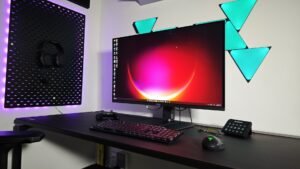Bluesound has long been some of my favourite audio hardware while writing for CGMagazine. They have built an audio ecosystem that works flawlessly together, while delivering industry leading sound that puts many of the other options to shame. The Bluesound Node 2i was an amazing offering, bringing the world of audio, including games, to the Bluesound ecosystem, and now, the Canadian audio company has iterated once again, delivering an updated offering that is sure to please anyone that loves quality with their connected audio.
Much like past Node devices, the new Bluesound Node 2021 model brings with it the Bluesound feel and style that makes it immediately striking in any setup. From the clean appearance of the device to the minimalistic display, the brand keeps the style constant, and in line with the level of quality we have come to expect. From the design to the level of features, it can’t be overstated just how impressed I was with the latest Node, and how it is now the new benchmark I use to look at audio.

Unboxing the Node (2021) and the attention to detail was felt throughout the experience up to and including the setup process. The BluOS app made everything painless, needing to just have the Bluesound Node connected to power, an Ethernet cable, and we were ready to get things going. I had no issue getting the new system configured, with everything fully running within around 15 minutes, and this includes the update process the hardware needed to get connected.
For testing, we were sent a Pulse Mini 2i to properly experience how it all connects to the Bluesound ecosystem, and even though these were the only BluOS devices in the test environment, everything connected flawlessly, with the system finding the speaker and the Node without any issue, even with countless other devices clogging up the network. With any device that costs north of $500, this is expected, but I have seen more expensive hardware get stuck in the setup process, especially with a crowded network, so I am pleased at how painless things went overall.
“Much like past Node devices, the new Bluesound Node 2021 model brings with it the Bluesound feel and style that makes it immediately striking in any setup.”
The Bluesound Node has a range of connections to bring your media into the system. On the back of the device, you have the option for Mini TOSLINK/3.5 mm Stereo combo, and HDMI eARC input. The Node also outputs into a range of connections, including RCA, coaxial, optical, subwoofer, and 3.5 mm, so you should be able to configure the system in a way that works best for your gear and needs. There is also the option to connect and send audio via Apple AirPlay 2 and aptX HD Bluetooth should you hate the thought of wires at all.


While you can splurge and pick up the Bluesound RC1 remote control, all playback controls are found in the BluOS app. This includes everything from audio settings, playback, audio sources, and even streaming service control. The app is one of the more intuitive experiences, giving easy access to the tools you need, while never making the overall app feel cluttered or overstuffed. You can also control all your digital music library from here, making it very much like your audio control centre. Now in the world of digital assistance, BluOS also now gives you the ability to control Bluesound devices using voice commands with either Alexa or Google Assistant, provided you activate the BluVoice skills.
For 2021, the new Node has some welcome updates under the hood. Now boasting a quad-core 1.8GHz ARM Cortex A53, making a much-needed update compared to the single-core ARM Cortex A9 on the previous generation of Node. This update is immediately noticeable, giving the overall experience a faster, more fluid feel. You will spend less time waiting, and more time enjoying music, and the added power will give you plenty of headroom should Bluesound update the software in the future. The new update also offers the ability to play high-resolution audio up to 24-bit/192kHz.
“Now boasting a quad-core 1.8GHz ARM Cortex A53, making a much-needed update compared to the single-core ARM Cortex A9 on the previous generation of Node.”
The new Node can also stream just about any audio file you can throw at it, except DSD, although these can be converted to FLAC to be played. This means any digital media library you have and want to experience in a multiroom setup, you can, and the Node will play it as it was meant to be heard. Beyond local audio files, BluOS allows for a wide range of streaming services, including Tidal, Spotify, Amazon Music, Apple Music, and Qobuz, so you will have no issue finding something that will make your ears very happy.

Audio sound quality on the Bluesound Node sounds heavenly, with the help of their next-gen 32-bit/384kHz DAC that supports 24 bit/192kHz audio processing plus MQA decoding. The DAC delivers fantastic audio no matter what you feed in, it is even better at cleaning up lower-quality audio, making some internet radio and streams sound listenable where they would be painful on many other players on the market.
I was amazed at how well the Bluesound Node managed with all the audio, even stuff Sonos could not deliver in true high definition. While Sonos can process audio at 24-bit content encoded at sampling rates up to 48kHz, the Node can manage a much wider range, taking on audio all the way up to 192kHz, making for some truly fantastic listening experiences provided you have the music to push the multiroom system.
“The new Node can also stream just about any audio file you can throw at it, except DSD, although these can be converted to FLAC to be played.”
Bluesound is known for the wireless speakers that can blanket a house, with up to 64 BluOS devices scattered around your house delivering crystal clear audio. The Node is the centre of that setup, bringing the analog and external media into the ecosystem, and it does that fantastically well. Plugging in the TV for testing, I was able to experience how movies and games on the PlayStation 5 and Xbox Series X sound, and it was astounding how much difference good audio gear can mean to the media consumption experience. Bluesound should be pleased, they have taken on a competitive market and still managed to deliver something that exceeded my expectations.

Good movie and game audio aside, the Bluesound Node managed to offer up some incredible music, especially when paired with the Pulse Mini 2i. From the loud metal of Sabaton or Opeth, to the more mellow classical of some of the best symphonies in the world, if there is an audio genre you love, the Node can ensure it sounds as it is intended. Crystal clear audio, that feels robust while never overpowered or muddy is something I look for in my devices, and Bluesound delivers it.
Bluesound players are devices you buy when you demand quality along with the joys of multiroom audio. There are plenty of options currently on the market, but few boast the same level of features, compatibility or pure audio quality. That is why I can’t recommend Bluesound enough, it brings that all to the table all the while making the experience painless and a joy to indulge in. The Bluesound Node feels like the perfect evolution of an already fantastic product, and a must-have for anyone already invested, or looking to invest in the Bluesound ecosystem.






